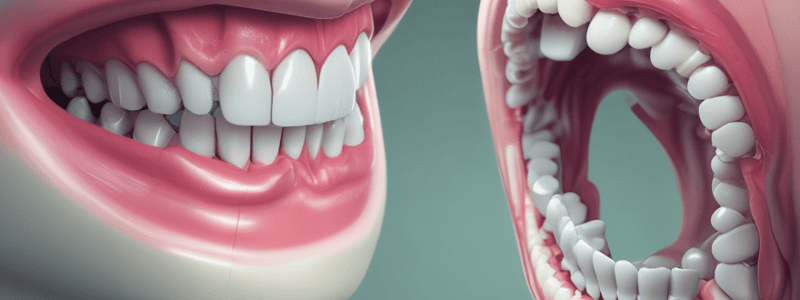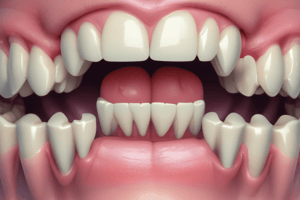Podcast
Questions and Answers
What is the primary function of opaque porcelain in a metal-ceramic restoration?
What is the primary function of opaque porcelain in a metal-ceramic restoration?
- To bond with the metal surface and mask its color (correct)
- To decrease the strength of the ceramic material
- To add translucency to the restoration
- To create a natural tooth color
What is the purpose of glazes in a metal-ceramic restoration?
What is the purpose of glazes in a metal-ceramic restoration?
- To add color to the restoration
- To increase the strength of the ceramic material
- To create a natural tooth shape
- To achieve a high-gloss finish (correct)
What is the term used to describe the process of creating a wax pattern, investing, and casting in metal-ceramic restorations?
What is the term used to describe the process of creating a wax pattern, investing, and casting in metal-ceramic restorations?
- Casting technique
- Waxing technique
- Lost wax technique (correct)
- Investment technique
What is the purpose of dentin porcelain in a metal-ceramic restoration?
What is the purpose of dentin porcelain in a metal-ceramic restoration?
What is the term used to describe the layers of ceramic material used in a metal-ceramic restoration?
What is the term used to describe the layers of ceramic material used in a metal-ceramic restoration?
What is the primary function of the body porcelain in a metal-ceramic restoration?
What is the primary function of the body porcelain in a metal-ceramic restoration?
What is the term used to describe the process of adding color to a metal-ceramic restoration?
What is the term used to describe the process of adding color to a metal-ceramic restoration?
What is the primary function of the metal coping in a metal-ceramic restoration?
What is the primary function of the metal coping in a metal-ceramic restoration?
What is the term used to describe the process of creating a metal substructure in a metal-ceramic restoration?
What is the term used to describe the process of creating a metal substructure in a metal-ceramic restoration?
Flashcards are hidden until you start studying
Study Notes
Lost Wax Technique
- The lost wax technique is used in fixed prosthodontics to create a metal framework for a dental restoration.
Waxing Up
- Waxing up is the process of rebuilding a prepared tooth on a die using wax.
- Wax is used because it can be conveniently manipulated and precisely shaped by heating, and it can be completely eliminated from the mold after investing.
- Inlay casting wax is a type of wax used in forming the pattern for cast restorations.
General Requirements of Wax
- The wax should have the following properties:
- Color: should be suitable for the specific application
- Flow: should be able to flow easily
- Carving: should be able to be carved accurately
- Addition: should be able to be added to without distorting the pattern
- Residue: should leave minimal residue after removal
- Compensation: should compensate for metal shrinkage
- Strength and rigidity: should have sufficient strength and rigidity after cooling
Step-by-Step Process
- Modification of the master cast
- Addition of wax layers
- Dipping the first layer, followed by anatomical buildup of the wax pattern by addition
- Evaluation
- Axial contours
- Occlusal morphology
- Margins
Removable of Wax Pattern
- Remove the pattern from the die using extreme caution not to distort it
Spruing
- A sprue is a channel in the investment material through which molten wax can escape during the burnout process, and molten metal can reach the mold cavity.
- Requirements for a sprue:
- Allow molten wax to escape from the mold
- Enable molten metal to flow into the mold
- Molten metal inside the sprue must remain molten slightly longer than metal that had filled the mold
- Types of sprue formers:
- Wax
- Plastic
- Metal
Properties of Sprue
- Diameter: should be thicker than the thickest portion of the pattern
- Location: should be attached to the bulkiest non-critical part of the pattern, away from margins and occlusal contacts
- Angulation: should be at an angle (45°) to allow the incoming molten metal to flow freely to all portions of the mold
- Length: should be according to the investment used, with a minimum of 6-8 mm for gypsum-bonded investment and 3-4 mm for phosphate-bonded investment
- Venting: small auxiliary sprues or vents improve casting of thin patterns and help gases escape during casting
Casting
- Done using a centrifugal casting machine or air pressure casting machine
- Molten metal is cast into the mold
Casting Defects
- Can be attributed to poor casting technique and failure to adhere to casting laws
- Types of defects:
- Rough casting
- Large nodules
- Small nodules
- Fins
- Incomplete casting
- Marginal discrepancy
Cleaning the Casting
- After solidification, the ring is removed and quenched in water
- Divesting: removal of the casting from the investment mold
- Pickling: process of removing oxides and tarnish from the surface of the casting using an acid
Porcelain Build-up
- Ceramic layers are built up on a metal coping
- Types of porcelain:
- Opaque porcelain
- Body porcelain
- Incisal porcelain
Studying That Suits You
Use AI to generate personalized quizzes and flashcards to suit your learning preferences.




